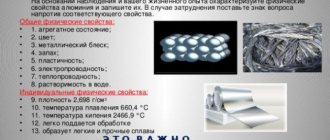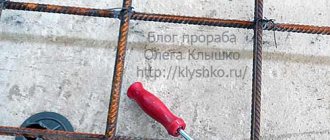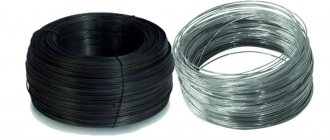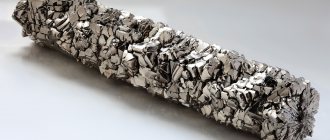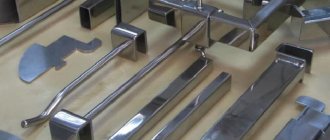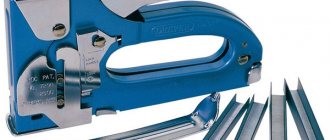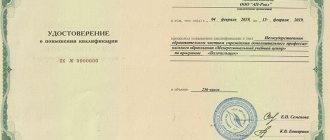Knitting wire is a material that is used in the construction of high-rise monolithic structures. Knitting wire is used to connect frame reinforcement elements.
Application areas of knitting frame wire:
- mesh rope;
- Rabitz;
- protective wire;
- masonry mesh;
- package.
Scope of application of knitting wire
In addition to its main application in construction, wire for tying reinforcement is often used in other areas:
- Manufacturing of ropes.
- Production of masonry nets.
- Making barbed wire.
- Production of chain-link mesh.
- Product packaging.
- Securing cargo for transportation.
Knitting wire is most popular in monolithic construction. It is used for reinforcing the following reinforced concrete and concrete products:
- Foundations.
- Walls, lintels, beams, columns.
- Stairs.
- Monolithic floors.
- Floor screed.
Marking
In order to correctly place an order if you need to purchase heat-treated knitting wire that meets the standards of GOST 3282-74, you need to know how the product you are interested in is designated. Here are some examples of markings.
- Light wire (C), heat-treated (O), increased production precision (P) and a diameter of 1.8 mm is designated as follows: “Wire 1.8-P-OC GOST 3282-74”.
- In the designation of knitting wire produced with normal accuracy, this characteristic is not displayed by any symbol. Taking this into account, the marking of long-length hardware products, characterized by normal accuracy, having a diameter of 1.6 millimeters, undergone heat treatment (O), and on the surface of which there is scale (Ch), is as follows: “Wire 1.6-O-Ch GOST 3282-74".
Characteristics of tying wire
The most important characteristics of knitting wire are tensile strength and flexibility. It must reliably connect intersecting reinforcement bars, and also be soft for quick execution of work.
This uncoated material is produced with a diameter from 0.2 to 6 mm. Galvanized knitting wire can have a diameter of up to 10 mm. To improve strength and elasticity, it is subjected to heat treatment during the production process. When choosing unfired wire, characteristics such as tensile strength (N/mm2) and cross-sectional area (mm2) should be taken into account.
Main product characteristics
The blank for the production of knitting wire is wire rod, which is cold drawn. The starting material is low-carbon steel with a carbon content of up to 0.25%. An important technological process in the manufacture of these products is heat treatment - annealing, which consists of heating the wire followed by slow cooling in furnaces - bell-type, shaft, linear type. The purpose of this operation is to restore the crystal lattice of steel, deformed during cold drawing, and to reduce residual stresses in the metal. Wire that has not undergone heat treatment bends poorly and often breaks and breaks. Annealed products are convenient for tying knots, and most importantly, they firmly fix the reinforcement in the installed position.
There are two types of annealing used in the production of tying wire for reinforcement:
- light - carried out in bell furnaces in the presence of inert gas. The surface of such products is clean without scale, the cost is higher. In the marking, this type of maintenance is designated by the letter “C”;
- dark - occurs in the presence of oxygen, so the surface of the wire turns out dark, with the presence of scale. Products after such heat treatment are marked with the letter “C”. Scale deteriorates the appearance of products and remains on the hands of workers, but the mechanical characteristics are not reduced.
Features of the production of wire for knitting reinforcement
Material: low carbon steel. The technological process is drawing the workpiece through die holes with the required diameter. During drawing, the structure of the steel improves and a hardened layer is formed on its surface. But after this, large internal stresses appear in the metal. Therefore, the following technological operation is carried out - stress-relieving annealing. After this, the material acquires the main positive properties: good bending strength and high ductility.
How much does wire 6 cost?
Wire 6
| Name | Diameter, mm | Price per unit, rub. |
| wire o/k 6 light | 6 | 84200 |
| wire o/c 6 galvanized | 6 | 94600 |
| wire o/k 6 otozh ots | 6 | 96800 |
| wire o/k 6 light | 6 | 84300 |
Types of steel tying wire
- The presence or absence of a protective coating
To obtain galvanized wire, it is kept in baths of molten zinc, therefore it is much less susceptible to corrosion and the influence of an aggressive external environment. - Heat treatment
There are untreated wires and those subjected to the annealing process. Annealed wire is marked with the letter “O”. - Strength class
It depends on the alloys used in manufacturing. Wire B-1 is made from ordinary low-carbon steel, and wire B-2 has additional alloying components added. Ordinary wire is used to make low-tension frames, and strong wire is used to knit prestressed reinforcement.
Maximum deviations in the diameter of knitting wire GOST 3282-74
| Nominal wire diameter, mm | Maximum deviation for wire diameter, mm | Nominal wire diameter, mm | Maximum deviation for wire diameter, mm | ||
| increased accuracy | normal accuracy | increased accuracy | normal accuracy | ||
| 0,16 | -0,02 | -0,02 | 1,10 | -0,05 | -0,06 |
| 0,18 | 1,2 | ||||
| 0,20 | 1,3 | -0,10 | |||
| 0,22 | 1,40 | ||||
| 0,25 | 1,60 | ||||
| 0,28 | -0,03 | -0,03 | 1,80 | -0,06 | |
| 0,30 | 2,00 | ||||
| 0,32 | 2,20 | -0,12 | |||
| 0,35 | 2,50 | ||||
| 0,36 | 2,80 | -0,10 | |||
| 0,37 | -0,04 | 3,00; 3,20 | |||
| 0,40 | 3,50 | -0,16 | |||
| 0,45 | -0,04 | 3,60 | |||
| 0,50 | 4,00 | ||||
| 0,55 | 4,50 | ||||
| 0,56 | 5,00 | ||||
| 0,60 | 5,50; 5,60; 6,00 | ||||
| 0,63 | -0,05 | 6,30 | -0,20 | ||
| 0,70 | 7,00 | ||||
| 0,80 | 8,00 | ||||
| 0,85 | 9,00 | ||||
| 0,90; 0,95; 1,00 | 10,00 | ||||
Classification of wire for tying reinforcement
GOST 3282-74 “Low-carbon steel wire for general purposes” indicates its classification according to the following criteria:
By type of processing
– with or without heat treatment (annealing).
By type of coverage
– with or without galvanized coating.
According to manufacturing accuracy
– with increased or normal accuracy.
According to temporary tensile strength
(for unannealed) – groups I and II.
Also, the wire for knitting can be light or black. Black is obtained by annealing in air, with the usual oxygen content. Light is obtained as a result of annealing in an environment of inert gases. In terms of parameters, light wire annealed in an inert gas is no different from black wire, but is more expensive.
Types and comparative characteristics
According to the main characteristics specified in GOST 2333-80, the wire is classified according to the shape and type of section, size, composition, surface treatment and finishing, area of use:
| Rental form | Section size | Chemical composition | Surface treatment | Surface finishing | Destination |
| Round | 1 group: up to 0.1 mm | Low carbon steel (carbon content no more than 0.25%) | Thermal | No additional finishing | Universal, general purpose |
| Shaped | Group 2: 0.1-0.2 mm | Carbon steel (more than 0.25%) | Released | Pulled after turning, grinding, roughing | For reinforcement of stressed metal structures |
| Rectangular | Group 3: 0.2-0.4 mm | Alloy steel | Annealed | Sanded | surfacing |
| Square | Group 4: 0.4-0.8 mm | High alloys | Normalized | Polished | Welding |
| Triangular | 5 group: 0.8-1.6 mm | Special types of alloys: heat resistant; corrosion resistant; heat resistant; precision. | Combined (tempered hardened) | Etched | Spoke |
| Trapezoidal | 6 group: 1.6-4 mm | Patented | With a metallic finish: · tinned; · with galvanization; · with copper coating; · coated in aluminum or brass. | Ropeway | |
| Hexagon | 7 group: 4-6 mm | Stabilized (processing under voltage) | With a finishing non-metallic coating (phosphated, with polymer painting) | For flexible pull of arrows and signals | |
| Oval | 8 group: 6-8 mm | Unheated | Treated light with tarnished colors | For reinforcing products of various types | |
| Z-shaped | 9 group: more than 8 mm | Cold rolled | Heat treated black with scale | Spring | |
| Segmental | Cold drawn | String; For the production of reinforcing mesh | |||
| X-shaped | Heat drawn (hot rolled) | For the production of cables of various types and purposes | |||
| Special profile | Calibrated | Bandage | |||
| Periodic profile | Linking |
The most commonly used wire types are:
● made of low-carbon steel (universal, complies with GOST 3282-74);
● made of low-carbon steel, cold-drawn (used for knitting and reinforcing concrete products, complies with GOST 6727-80);
● carbon steel (used for stressed reinforced concrete structures, knitting metal frames, complies with GOST 7348-81);
● welding steel (universal, complies with GOST 2246-70);
● made of low-carbon steel (general purpose, complies with GOST 3282-74).
Surface type and finish can be customized according to customer's requirement. Most often, standard black wire is used, but when in contact with aggressive environments, light galvanized wire or with protection in the form of polymer painting is recommended. Protective coating of copper, brass, and aluminum is also allowed to impart the required properties to the rolled product.
How much does 1 meter of wire cost?
Knitting wire (in coils)
| Name | Length (m) | Price |
| wire 3 mm | Length (m) As per order | Price 100 rub. |
| wire 4 mm | Length (m) As per order | Price 100 rub. |
| wire 5 mm | Length (m) As per order | Price 100 rub. |
How to make wire for knitting
The main technology for producing wire for tying reinforcement is drawing. The steel blank is pulled through a special device (drawing machine). Its peculiarity is the presence of a gradually decreasing internal diameter. When drawn through such a hole, the metal is compressed and at the exit forms a product of the required cross-section and dimensions.
Drawing is a cold process. During this production, steel crystals are compressed, forming a dense lattice. The drawn wire, due to pressure treatment, is characterized by high hardness. However, such material is not flexible and brittle. In this state it is less suitable for tying reinforcement. When bent, it may crack at the bend.
To give the product the desired properties of ductility and bending strength, the resulting workpiece is sent to the furnace for annealing. It is heated to high temperatures and subjected to tempering (gradual cooling). During heat treatment, the structure of the iron lattice is normalized. Due to this, the final product will have sufficient flexibility, strength and becomes suitable for tying in reinforcement work.
The marking of the annealed material must contain the designation “O”. There are heat-treated soft wires for knitting:
- Black. The workpieces are heated using oxygen. In the process, the metal oxidizes, which makes it less durable and resistant to stress. The cost of this type of binding wire is the lowest. But it is not suitable for the construction of critical structures.
- Gray. Produced using inert gases when heated in an oven. Due to the lack of access to oxygen, iron does not oxidize, maintaining the required qualities: strength, flexibility, corrosion resistance. This building material can be used for tying reinforcement in the construction of load-bearing structures, foundations, etc.
Methods for connecting reinforcement using knitting hardware
To form a frame from reinforcement with a cross-section of 10–14 mm, knitting wire with a diameter of 1.2–1.4 mm is used. If the product has poor elasticity, the coil should be placed in an open fire, such as a fire, for half an hour. Then leave to cool at ambient temperature. You can use material with a smaller diameter, but in this case you will need double bending of the material and an increased number of nodes.
To do the job well, you need a special crochet hook, which you can purchase at a hardware store or make yourself from a paint roller by bending and sharpening its ends.
Knitting reinforcement using a hook
Knitting is done quite simply by following these steps:
Wire knitting techniques
- cutting the material into equal pieces;
- folding the desired piece in half;
- hardware is wrapped diagonally at the intersection of the reinforcement;
- a special hook is threaded into the resulting loop;
- wire ends are pulled into the loop;
- the hook rotates clockwise several times;
- a strong knot with four to five turns is formed, fixing the reinforcement.
Knitting wire is sold in coils weighing 5 kg, where the length of the product is up to 120 m, or in coils weighing from 50 to 300 kg. In five-kilogram packages, hardware is of continuous length, and in larger packages, no more than three sections can be wound.
Related video: Knitting wire for reinforcement
Publications on the topic
Features of knitting reinforcement for a strip foundation
Rules for calculating the consumption of tying wire per 1 ton of reinforcement
Types and area of application of fireclay bricks
